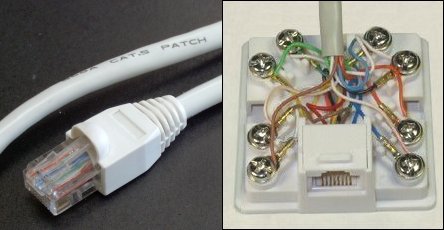In 1985, the Computer Communications Industry Association (CCIA) requested the Electronic Industries Association (EIA) to develop a generic cabling standard for commercial buildings that would be capable of running all current and future networking systems over a common topology using a common media and common connectors.
By 1987 several manufacturers had developed Ethernet equipment which could utilise twisted pair telephone cable, and in 1990 the IEEE released the 802.3I Ethernet standard 10BaseT (the T refers to Twisted pair cable). In 1991 the EIA together with the Telecommunications Industry Association (TIA) eventually published the first telecommunications cabling standard called EIA/TIA 568, the structured cabling system was born. It was based on Category 3 Unshielded Twisted Pair cable (UTP), and was closely followed one month later by a specification of higher grades of UTP cable, Category 4 and 5.
The table below shows the different types of UTP commonly in use at the end of 2000:
| Type | Characteristics |
|---|---|
| Category 1 | Used for telephone communications and is not suitable for transmitting data |
| Category 2 | Capable of transmitting data at speeds up to 1Mbit/s. |
| Category 3 | Used in 10BaseT networks and capable of transmitting data at speeds up to 16Mbit/s. |
| Category 4 | Used in Token Ring networks and capable of transmitting data at speeds up to 20Mbit/s. |
| Category 5 | Capable of transmitting data at speeds up to 100Mbit/s. |
Recent developments in Ethernet technology have led to the introduction of Enhanced Category 5 which, like basic Category 5, is capable of transmission rates up to 100 Mbit/s. However, the test parameters for basic Category 5 assumed that data signals would only use two of the four pairs (one pair for transmitting and one pair for receiving) and crosstalk measurements were only taken between each pair combination. With Gigabit Ethernet however, all four pairs can be used to transmit simultaneously, and so the cross talk on each pair has to be measured for the combined effects of the other three pairs. Enhanced Category 5 can be used with Gigabit Ethernet.

IEEE 802.3 provides for a wide variety of cabling options using the various forms of UTS cable:
- The connecting cable for Standard Ethernet (10Base5) – also called Thick Ethernet and ThickNet – is referred to as an attachment unit interface (AUI), and the network attachment device is called a media attachment unit (MAU), instead of a transceiver. 10Base5 uses a thick coaxial cable that can run as far as 1,640 feet without using repeaters. Attachment is made by clamping an MAU onto the thick coaxial cable, which contains another cable that is connected to the adapter card via a 15-pin socket (AUI port).
- Twisted pair Ethernet (10BaseT) generally takes advantage of existing, economical, telephone wiring. It is wired in a star configuration, with all nodes connecting to a central hub using twisted pair wires and RJ45 connectors.
- Fast Ethernet (100BaseT) is the IEEE 802.3u-compliant high-speed version, similar to 10BaseT, but using different cabling configurations. 100BaseTX uses two pairs of Category 5 UTP, 100BaseT4 uses four pairs of Category 3, and 100BaseFX uses multimode optical fibres and is primarily intended for backbone use.
- Thin Ethernet (10Base2), also called ThinNet and CheaperNet, uses a thinner, less-expensive coaxial cable that is easier to connect but has a limitation of 607 feet per segment. ThinNet uses T-type BNC connectors, and the transceivers are built into the adapter cards.
- Fibre-optic Ethernet (10BaseF and 100BaseFX) is impervious to external radiation and is often used to extend Ethernet segments up to 1.2 miles. Specifications exist for complete fibre-optic networks as well as backbone implementations. FOIRL (Fibre-Optic Repeater Link) was an earlier standard that is limited to 0.6 miles distance.
Proposals have been made for Categories 6 and 7, but as of early 2001, these had not yet been ratified. Level 6 is slated to be capable of transmission speeds of over 200 Mbit/s using improved cables and RJ45 connectors. It will require use of cables and connectors which have been designed to work together as a tuned system. Mixing Category 6 components from different manufacturers will not therefore be possible.
Category 7 is proposed to be a 600 Mbit/s system using a shielded cable with individually screened pairs and a new type of connector. The cable and connectors are slightly bigger than Category 5. The drawback with Category 7 is that because of the ubiquity of RJ45 jacks, many cabling systems will require use of Category 7 to Category 5 patch leads, effectively reducing the system’s performance to that of the weakest link – 100 Mbit/s. By the time Category 7 is ratified many believe that fibre optic cable might be a cheaper alternative.
nice